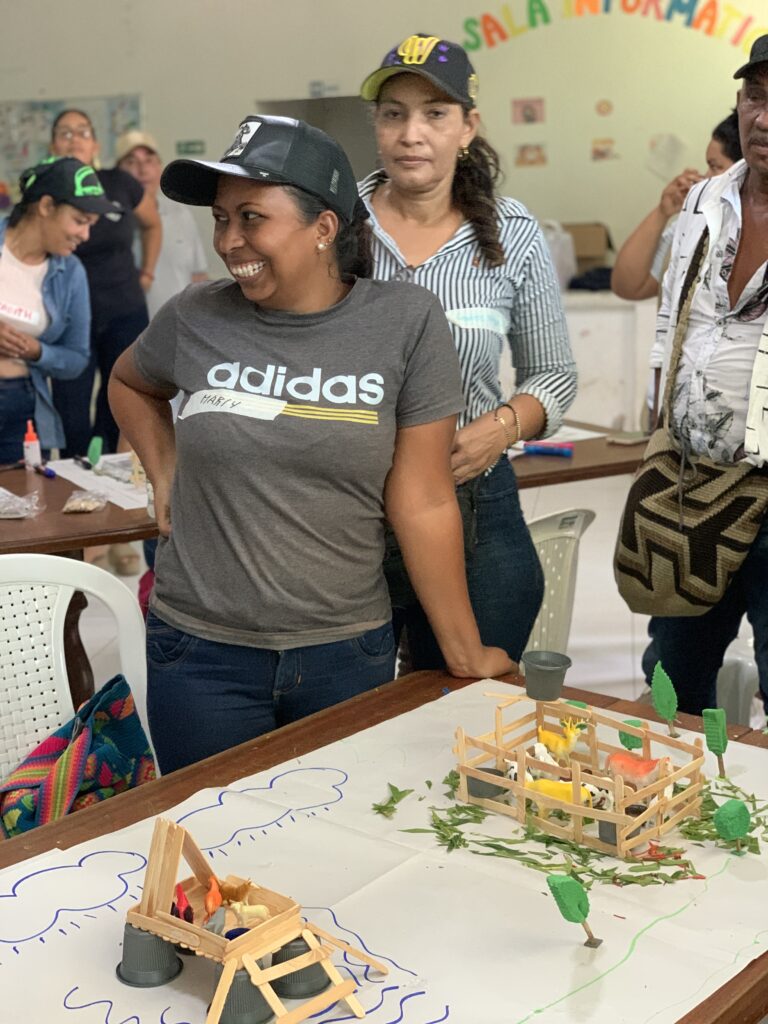A unique blend of technical training and grassroots engagement is helping rural communities in Colombia become better prepared for disasters. In June 2025, the Food and Agriculture Organization of the United Nations (FAO) organised a three-day LEGS Core Training in Sincelejo, followed by a first-of-its-kind awareness session in Majagual, bringing the LEGS approach directly to local communities.

Using toy farm animals and simulation games, participants collaborated to design flood response plans for livestock-reliant communities © Julia Lema Vélez
While the Sincelejo workshop equipped government officials from Sucre with technical tools for emergency livestock interventions, the Majagual session broke new ground by introducing LEGS principles to rural households – most of them women – in the flood-prone Mojana region. This marked the first time LEGS training was applied at community level in Colombia.
Practical tools for real challenges
The awareness session successfully adapted LEGS content to the local context and to the participants. Community members were introduced to the Participatory Response Identification Matrix (PRIM), a tool typically used by emergency professionals. They used it to identify which livestock interventions that would have the greatest impact in crises, boosting their ability to protect their animals and livelihoods.
The session also emphasized the multiple roles animals play – not just as economic assets but as sources of food, cultural meaning, and mental wellbeing. A species-by-species reflection – cattle, pigs, poultry, and horses – helped participants explore the deeper connection between animals and community survival.
Toy animals, real resilience
One of the most memorable exercises involved toy farm animals and simulation games. Participants worked together to design flood response plans, combining LEGS tools with traditional knowledge. Their solutions included:
- Evacuation rafts for livestock
- Raised poultry pens to avoid floodwaters
- Elevated water tanks for drought resilience
- Quarantine zones and silage reserves
As one participant said, “Before, we just waited for help. Now we know how to prepare and protect what’s ours.”
Women at the centre
Women made up 90% of participants in Majagual – and their leadership was unmistakable. Their engagement demonstrated how central they are to managing risk at both household and community levels. As one woman noted, “What I value most is understanding that protecting our animals is protecting our future.” Another added, “If this happens again, we may not need help from the State, but from our community. That makes us stronger.”
Looking ahead
The initiative showed that tools designed for humanitarian professionals – like PRIM and the LEGS framework – can be effectively adapted for community use. It is recommended to replicate both the training and awareness sessions in other livestock-reliant regions such as Córdoba and Bolívar, reinforcing the message that true resilience begins when communities lead.
Strengthening Livestock Emergency Preparedness through LEGS Training |
|---|
|
The LEGS Core Training brought together key actors from the Government of Sucre, who received hands-on training in LEGS tools such as the Participatory Response Identification Matrix (PRIM) and decision trees. The focus was on community participation and interinstitutional coordination, using participatory methodologies, simulations, and real-world case studies. Participants expressed high satisfaction with the course, recognizing LEGS as a key international standard to protect livestock, reduce food insecurity, and accelerate recovery. They gained skills to prioritize emergency interventions (e.g., water and feed supply, veterinary care), integrate LEGS into institutional risk management plans, and promote cross-sector coordination. LEGS was also seen as a valuable tool for climate adaptation and disaster prevention. Trainers Julia Lema Vélez and Diego Hernández Pulido were praised for their clear, dynamic, and professional facilitation. The interactive design and “learning by doing” approach received enthusiastic feedback. |

